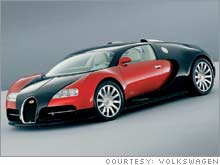Walmart is one of the creepiest firms in the US (and one of Wall Street’s favourites). It pays its employees so little that many of them are eligible for food stamps. And, as part of its ‘human resources’ services, it even provides help desks which advise employees on how to claim for this kind of welfare. Now, according to this week’s Economist, the company’s Chief Executive has said that “Congress should consider increasing the minimum wage.” The thought that Walmart might increase its employees’ minimum wage without troubling Congress doesn’t seem to have occurred to him.
Category Archives: Beyond belief
Apropos Harriet Miers’s nomination to the Supreme Court…
… this from Martin Kettle, writing in yesterday’s Guardian:
Back in the dawn of American constitutional history, Alexander Hamilton set out the reasons why it was important to have the Senate act as a check on presidential nominations of this kind. The Senate, he wrote, needs to make a president “both ashamed and afraid to bring forward, for the most distinguished or lucrative stations, candidates who had no other merit than that of coming from the same state to which he particularly belonged, or of being in some way or other personally allied to him, or of possessing the necessary insignificance and pliancy to render them the obsequious instruments of his pleasure.”
Earlier in the week, Bush was asked: “Of all the people in the United States you had to choose from, is Harriet Miers the most qualified to serve on the supreme court?”. The president answered “Yes”.
Why home printing is a racket
From today’s New York Times…
It does not take an advanced business degree for those consumers to see how printer manufacturers like Hewlett-Packard and Canon make their money. They use the “razor blade” business model. It is named from the marketing innovation of King C. Gillette, who in the early years of the last century sold razors for a low price but made all his money on the high-margin disposable razor blades. Printer manufacturers also use this tied-product strategy.
Printers return relatively low profit margins. But the ink, ounce for ounce, is four times the cost of Krug Clos du Mesnil Champagne, which sells for around $425 a bottle. Ink is about the same price as Joy perfume, considered to be one of the more pricey fragrances, at $158 for a 2.5-ounce bottle.
Kodak’s bid to own your pictures
You couldn’t make this up. But I’ll let Dan Bricklin (a keen digital photographer) tell the story…
The idea of a “Wi-Fi” camera seems exciting but in trying to understand it I found that it comes with a big boat anchor — the photos are uploaded to Kodak’s site. But you don’t really own the pictures. If you ask they will sell your photos to you and deliver them to you on a CD (no downloads!) which contains your entire collection of pictures! According to their site you can’t even specify which photos — you have to pay according to how many photos are in your account!
Since the site and rules may change there’s what KodakGallery (formerly Ofoto) currently says: “When you order an Archive CD, your entire photo collection will be preserved on CD. Photos are saved as full-sized JPEGs in their original resolution. Archive CDs are priced according to the total number of photos in your account.”
While the idea of having your photos automatically moved from your camera to the Internet sounds wonderful, you lose ownership of your own pictures. Or maybe you shouldn’t think of them as yours — they effectively belong to Kodak and you get only controlled access. As much as Kodak seems to want to leave their silver-halide heritage behind they seem to be stuck in the old business model of making money when you process the picture, when you print the picture and whenever you want to print it again. It’s another example of how hard it is for a company to change its basic nature.
This is part of the larger trend that is fighting to keep control. The record industry doesn’t want to let you have any control over the bits you buy and Tellywood wants to wrap everything in a very tight DRM straightjacket. These are a business premised on control and they seem unable to change their basic nature. For them it makes a lot of sense to fight the future as long as they can. They have no better option and if they are smart they are taking cash out so when their business evaporates they can retire.
Copyright thugs seek to break up family
From Good Morning Silicon Valley…
The heavy armor of the music industry’s legal department continues to clank forward, but a few people are starting to stand up in front of the tanks. One is Candy Chan, sued for alleged copyright infringement by a batch of record companies. The subject of the investigation actually was Chan’s then 13-year-old daughter, Brittany, aka “Spicybrnweyedgirl.” According to a p2pnet report, when Chan refused to settle on behalf of her daughter, the record companies regrouped and now want to go after the teenager directly — but first they want the court to push Mom aside and appoint a legal guardian in this matter.
Exploding ‘Intelligent Design’
Jerry Coyne has performed a remorseless dissection of the idiocies of ‘Intelligent Design’ in The New Republic.
Crazy pairings
A few miles further on, we came on this sign.

Now, Sawtry is a quiet and undistinguished village in deepest Cambridgeshire. What it’s doing twinned with one of the great cultural sites of Europe — home to Bach, Goethe, Schiller and Herder — is beyond me. Apart from giving its name to a period in recent German history, Weimar has (so I learn from Wikipedia) been “a site of pilgrimage for the German intelligentsia since Goethe first moved there in the late 18th century”. It seems that Goethe, Schiller and Nietzsche are buried there, and it houses the archives of Goethe and Schiller. I cannot for the life of me seeing anyone making a pilgrimage to Sawtry. So how this this bizarre coupling come about?
The new arithmetic
Let’s see, now. Take the cost of rebuilding New Orleans and the three devastated states — say $200 billion. Add the cost of running that war over in Iraq — say $100 billion and rising. Call it $300 billion. Time to call a halt to tax cuts.
Not a bit of it.
Here’s Dubya’s latest word on the question:
On Friday, Bush ruled out raising taxes to pay the massive costs of Gulf Coast reconstruction, saying other government spending — which neither he nor his aides identified — must be cut to pay for a recovery effort expected to swell the budget deficit by $200 billion or more.
“You bet it’s going to cost money. But I’m confident we can handle it,” he said at a White House news conference with Russian President Vladimir Putin.
Congress already has approved $62 billion for the disaster, but that is expected to run out next month and require another budget-busting installment. The federal deficit was projected at $333 billion for the current year before the storm slammed into the Gulf Coast more than two weeks ago. Some fiscal conservatives are expressing alarm at the prospect of massive additional federal outlays without talk of what other spending to cut.
The Seattle Times comments that
The proposed record reconstruction spending in the wake of Hurricane Katrina, estimated as high as $200 billion, is all but certain to add to a mushrooming national debt that already has the country dependent on foreign investors.
The sum is about equal to what has been spent on the wars in Iraq and Afghanistan. It’s almost half the size of this year’s domestic discretionary spending, essentially everything the government does besides national defense, Social Security, Medicare and Medicaid.
President Bush vowed yesterday to rebuild the tattered Gulf Coast, “whatever it costs.” He ruled out tax increases, which means the new spending will add to the burden on taxpayers from the federal budget deficit, now $331 billion, and the national debt, now $4.6 trillion.
“It means we’re going to have to make sure we cut unnecessary spending,” Bush said. “It’s going to mean that we maintain economic growth and we should not raise taxes.”
That Bush speech in New Orleans
Lovely column by Maureen Dowd…
In a ruined city – still largely without power, stinking with piles of garbage and still 40 percent submerged; where people are foraging in the miasma and muck for food, corpses and the sentimental detritus of their lives; and where unbearably sad stories continue to spill out about hordes of evacuees who lost their homes and patients who died in hospitals without either electricity or rescuers – isn’t it rather tasteless, not to mention a waste of energy, to haul in White House generators just to give the president a burnished skin tone and a prettified background?
The slick White House TV production team was trying to salvage W.’s “High Noon” snap with some snazzy Hollywood-style lighting – the same Reaganesque stagecraft they had provided when W. made a prime-time television address from Ellis Island on the first anniversary of the 9/11 attacks. On that occasion, Scott Sforza, a former ABC producer, and Bob DeServi, a former NBC cameraman and a lighting expert, rented three barges of giant Musco lights, the kind used for “Monday Night Football” and Rolling Stones concerts, floated them across New York Harbor and illuminated the Statue of Liberty as a backdrop for Mr. Bush.
Before the presidential address, Mr. DeServi was surveying his handiwork in Jackson Square, crowing to reporters about his cathedral: “Oh, it’s heated up. It’s going to print loud.”
1,001 horsepower, $1.24 million, no brains
If you want to know why VW is in trouble, look no further!

Each Bugatti Veyron 16.4 will cost an estimated $1.24 million, according to media reports. For that, buyers will get an all-wheel-drive two-seat sports car with a lightweight carbon-fiber body and 16-cylinder engine capable of producing 1,001 horsepower.
Oh, and according to Automotive News, this hideous vehicle still suffered from two major problems: The enormous engine tended to overheat and the car, capable of a top speed of well in excess of 200 miles per hour, was unstable at high speeds. Wouldn’t it be nice if Jeremy Clarkson bought one and then totalled it — and himself — thereby ridding the world of two excrescences in one fell swoop.
